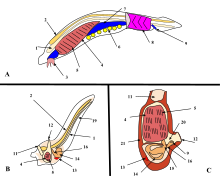Alexander Kovalevsky
Alexander Kovalevsky | |
|---|---|
 Alexander Kovalevsky | |
| Born | 7 November 1840 |
| Died | 1901 |
| Nationality | Russian |
| Citizenship | Russian |
| Alma mater | University of Heidelberg |
| Known for | Gastrulation |
| Scientific career | |
| Fields | Embryology |
Alexander Onufrievich Kovalevsky (Russian: Алекса́ндр Ону́фриевич Ковале́вский, 7 November 1840 in Vorkovo, Dvinsky Uyezd, Vitebsk Governorate, Russian Empire – 1901, St. Petersburg, Russian Empire), was a Russian embryologist, who studied medicine at the University of Heidelberg and became professor at the University of St Petersburg.[1][2][3][4] He was the brother of paleontologist Vladimir Kovalevsky, and the brother-in-law of the mathematician Sofya Kovalevskaya.
Discoveries[]
Kowalevsky showed that all animals go through a period of gastrulation.[1][2][3][4]
Kovalevsky discovered that tunicates were not molluscs, but that their larval stage had a notochord and pharyngeal slits, like vertebrates. Further, these structures developed from the same germ layers in the embryo as the equivalent structures in vertebrates, so he argued that the tunicates should be grouped with the vertebrates as chordates. 19th century zoology thus converted embryology into an evolutionary science, connecting phylogeny with homologies between the germ layers of embryos, foreshadowing evolutionary developmental biology.[5]

Bibliography[]
- Kowalevsky, A (1901). "Les Hedylidés, étude anatomique". . 12: 1–32.
References[]
- ^ Jump up to: a b Ereskovsky, Alexander (2012). "Introduction to the Kowalevsky medal issue" (PDF). Evolution & Development. 14 (1): 1–2. doi:10.1111/j.1525-142X.2011.00516.x. PMID 23016968. S2CID 46420506.
- ^ Jump up to: a b Fokin, Sergei I. (2012). "Life of Alexander Onufrievich Kowalevsky (1840–1901)". Evolution & Development. 14 (1): 3–8. doi:10.1111/j.1525-142X.2011.00517.x. PMID 23016969. S2CID 205674995.
- ^ Jump up to: a b Haas, L F (May 1999). "Alexander Onufrievich Kovalevsky (1840-1901)". J. Neurol. Neurosurg. Psychiatry. 66 (5): 680. doi:10.1136/jnnp.66.5.680. PMC 1736354. PMID 10209188.
- ^ Jump up to: a b Kyle, R A; Shampo M A (Sep 1982). "Alexander O. Kovalevsky". JAMA. 248 (11): 1336. doi:10.1001/jama.248.11.1336. PMID 7050433.
- ^ Gilbert, Scott F. (2003). "The morphogenesis of evolutionary developmental biology" (PDF). International Journal of Developmental Biology. 47 (7–8): 467–477. PMID 14756322.
- 1840 births
- 1901 deaths
- People from Vārkava Municipality
- People from Vitebsk Governorate
- Russian zoologists
- Full members of the Saint Petersburg Academy of Sciences
- Foreign Members of the Royal Society
- Recipients of the Pour le Mérite (civil class)
- Biologists of the Russian Empire
- People of the Russian Empire of Polish descent
- Russian embryologists
- Privy Councillor (Russian Empire)
